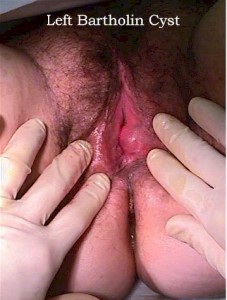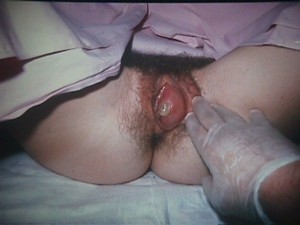There are two Bartholin glands, located on each side of the vaginal opening at the level of the posterior fourchette, or at about the 4 o’clock and 8 o’clock position.
Each gland is about the size of a pea. Normally, they are neither visible nor palpable.

These glands produce small amounts of secretions from their cuboidal epithelial lining that are not clinically significant. The secretions do not contribute meaningfully to sexual lubrication and their physiologic purpose, if any, is not known. Only when they become diseased do they become clinically apparent.
The secretions produced by Bartholin glands pass through a 2 to 3 centimeter, somewhat convoluted duct before reaching the skin surface. If a duct becomes obstructed (for example, from trauma, swelling, or infection), then the normal outflow of gland secretions may become blocked. The secretions will then gradually build up beneath the skin surface, and this collection of secretions is called a Bartholin cyst. Since the normal production of secretions is very modest, the development of a cyst is a slow process.
Bartholin cysts are first noticed as painless swellings in the labia majora. The patient may or may not be aware of it although usually they are aware. Bartholin cysts are not dangerous, have no malignant potential, and may be safely observed, if that is the patient’s desire. They can be confused with other cysts in the vulvovaginal area, including:
- Sebaceous cyst
- Vaginal inclusion cyst
- Gartner duct cyst
- Dysontogenetic cyst
Bartholin cysts may also be confused with:
- Fibromas
- Lipomas
- Hematomas
- Endometriomas
- Hidradenomas
- Syringomas
- Leiomyomas
- Myoblastomas
Other masses in the vulvar area that can mimic Bartholin cysts include:
- Accessory breast tissue
- Inguinal hernias
- Varicose veins
Should the Bartholin gland become infected, it will form a Bartholin abscess. In this case, the labia majora becomes excruciatingly painful, red and swollen. Some of these will drain spontaneously and this process may be hastened by warm moist dressings or sitz baths. Others will require drainage.

It is a relatively simple procedure to drain Bartholin cysts or abscesses.
Incision and Drainage of the abscess gives immediate relief.
Select a place for the incision. It should be on the medial side of the cyst, relatively close to the hymeneal ring, although if there is one area of obvious thinning of the epithelium, I’d aim for the thinnest part, so long as it still medial and in the mucous membrane.
Give local anesthetic of 1% Lidocaine over the incision site.
Steady the cyst or abscess with one hand while directing a scalpel into the center of the abscess.
Culture purulent drainage for gonorrhea and chlamyia. Only infrequently will these cultures be positive, but often enough to warrant your attention. Other commonly cultured organisms include coliforms and strep.
If loculations are present within the abscess cavity, break them up by inserting and then spreading a hemostat.
Antibiotic therapy is optional but usually used, particularly if the patient is febrile, the abscess large, or the skin is red or tender.
Simple incision and drainage of the abscess will provide immediate relief and more likely than not, permanent cure. In a significant minority of patients treated with simple I&D, the abscess or cyst will re-occur. This happens because after healing, the surgical opening into the cyst or abscess cavity seals over, resulting in isolation of the Bartholin gland beneath the skin. For this reason, more aggressive surgical treatment is sometimes used.
Packing the abscess cavity with gauze and leaving a wick external to the cavity is not an effective technique with Bartholin cysts and abscesses. Early in my surgical career, I used this method a number of times and never had the packing remain in the cavity for more than a few hours.
One commonly used, good technique to keep the drainage tract open is the insertion of a “Word Catheter.” A Word catheter is a soft rubber tube with an inflatable tip. After drainage is established, insert the tip of the Word catheter into the cavity and inflate the balloon tip with a few cc of any physiologic liquid such as sterile saline or lidocaine. The inflated balloon tip will keep the catheter from becoming dislodged and the stalk of the catheter will help keep the drainage tract open long enough for the cut skin edges to re-epithelialize to the inside of the cyst. Essentially, this results in a new duct connecting the Bartholin gland directly to the skin surface.
The stalk of the catheter is bent back and inserted into the vagina, so it can be left in place for many days. Ideally, it should be left for a few weeks, but it is irritating enough to the patient that it may need to be removed after several days. Even this short period of time is enough for it to be effective. Even with the Word catheter, there may still be recurrences of the cyst or abscess, but they are less frequent than with the simple I&D procedures.
Another way to accomplish the creation of a new drainage tract is to “marsupialize” the cyst or abscess. After opening the cyst, suture the squamous epithelial skin edge to the cuboidal epithelial cyst wall. This allows the cut skin cell fibroblasts the opportunity to spread down into the cyst, with creation of a new opening, allowing secretions to escape.
Other techniques, less well tested, include sclerosing the cyst cavity with silver nitrate, alcohol, or laser. Surgical tubing and IUDs have been used to maintain drainage. Good results have been reported in limited numbers of cases with each of these methods.
Finally, complete excision of the Bartholin gland is an option when other, simpler procedures have been unsuccessful. Excision should result in permanent cure, but it is technically challenging as the tissue planes may be scarred from old infection, bleeding may be surprisingly brisk, and healing more painful and protracted than you might think. In the end, the results are usually good.
Bartholin gland cancer is an uncommon malignancy, comprising about 5% of all vulvar cancers. It may be either adenocarcinoma or squamous cell carcinoma, since there are both glandular and duct epithelium present in the Bartholin gland.
Bartholin cancer is found about once in every 1 million women years. It’s usually discovered after unsuccessful treatment for a presumed Bartholin cyst or abscess. Treatment is radical vulvectomy and lymph node dissection. Because this malignancy is usually discovered only after multiple drainage procedures have failed, some gynecologists recommend excision of all Bartholin cysts or abscesses in women over age 40, when the risk of Bartholin gland cancer begins to rise.
Others disagree, observing that you would have to do hundreds of excisions of benign but annoying Bartholin cysts…with significant surgical morbidity…in order to somewhat improve the survival rate of the one individual with Bartholin cancer. These other voices recommend excision among women over age 40 only in selected cases.
